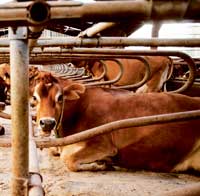Managing heat stress in your herd

Dairy farmers needs to be on the lookout for signs of heat stress in cows, with simple actions available to prevent problems.
That’s according to DairyCo extension officer Richard Davies, who says a cow’s preferred temperature is just 5C. It’s easy to see how she can begin to suffer from heat stress from temperatures as low as 22C if the relative humidity is high.”
Farmers may think that there is little that can be done to avoid heat stress, particularly given that the majority of cows are outside at this time of year. However, there are a number of actions that can be taken to minimise the risks.
“Providing spray cooling and helping the airflow in the collecting yard can really help,” adds Mr Davies.
“Increasing airflow over a cow also has a dramatic effect, evaporating heat loss from the skin. The results of research from the USA suggest that airflows as low as 10km/hr can reduce respiration rates in heat stressed animals by as much as 50%.”
“Providing plenty of water might seem an obvious point, but given that a cow needs up to 85 litres of clean water a day normally you need to be aware that in hot weather they can need up to half as much again due to sweating and respiratory losses.
Shady areas are vital outside but I’d advise keeping cows in during the hottest part of the day,” says Mr Davies.
Jamie Robertson of Aberdeen University agrees, “cow comfort is really important in the heat,” he says. “Cows will be in the collecting yard for up to four hours a day, so get holes in the roof or along the roof ridge, or take cladding off the sides.
“I don’t like to use ballpark figures but an open area in the roof of around 0.12sq m per cow is around the amount you should be looking at. Solutions don’t need to be complex, it can be as simple as taking an angle grinder to Yorkshire boarding or taking off sections of galvanised steel to allow more air into the building.
“If you have more of a budget, think about replacing boarding and breeze blocks with climate controlled blinds, which use heat and humidity sensors to open up automatically.”
